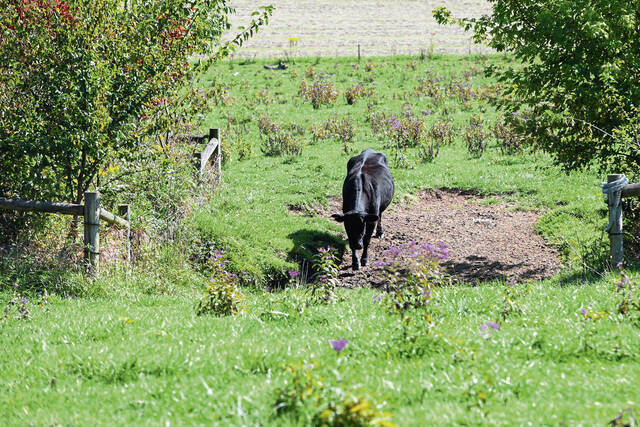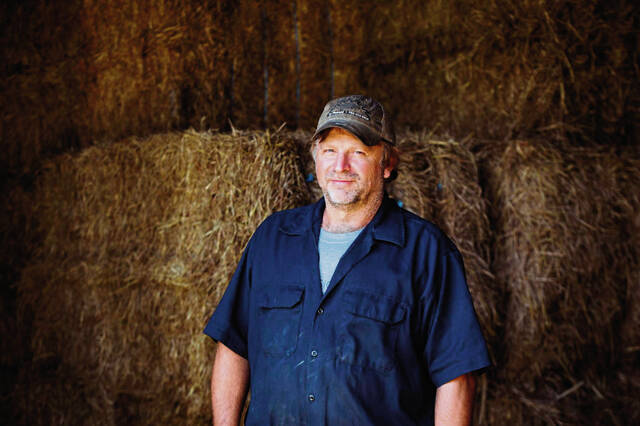Mt. Pleasant farmer’s 'cow-proofing' conservation work earns recognition
The stream at the corner of Mt. Pleasant Township area cattle farmer John D. Kitz’s property is surrounded by lush greenery.
Native wildflowers and leafy trees stick up from the stream bank, and a long, sturdy fence borders the clear water.
The plants, trees, fences and flowers make the stream a peaceful spot. More importantly, they make it cow-proof.
Fences prevent the livestock from trampling through the water and dirtying it with manure, while plants and trees hold the soil in, keeping erosion at bay.
Kitz’s work to restore the environment on his farm and protect his streams from damage has earned him and his family an award from the Westmoreland Conservation District. For his ongoing projects to stabilize the creeks that cross his property, Kitz was named the 2023 Conservation Farmer of the Year.
“If you don’t, it can’t sustain itself. A little mud puddle becomes a 20-acre mud pie. It just compounds,” said Kitz. “That’s what it’s all about — trying to work together with the environment. You can have the cattle and you can protect the stream, you can do it together.”
History of conservation work
Kitz’s farm, located on 140 acres along Hunter Hill Road, has been in the family since the 1960s. Today, the cattle farm is managed by John, with help from his wife, Kelly, and four sons, Jonathan, Joshua, Jeremiah and Jacob.
The farm has operated in conjunction with the conservation district for years. Kitz’s father, John G. Kitz, connected with them in 2012 to improve stream areas on the land.
The conservation district and Kitz family worked to reduce access to the stream for the farm’s 70 to 140 cattle. They added fencing, stabilized stream crossings, planted trees and shrubs along the stream, and provided an alternate source of water for the cows.
Kitz also practices rotational grazing on his farm, moving the herd from pasture to pasture every few days so that the grass has a chance to regrow. This makes the soil less compacted, which allows it to better retain moisture.
He also built a roofed animal heavy use area near the new stream project, which will protect the cattle and feeding area when they eat their hay. These areas shield surfaces from the cattle’s hooves, and reduce mud, which could otherwise find its way into the streams.
“You’d be surprised at how much a cow can move dirt,” Kitz said.
A week ago, Kitz started a new project on an adjacent portion of his property. At that stream, the bank is bare and dusty, and cows have trampled over the water for years while grazing. The next steps in fixing the new stream will be to plant trees and flowers to keep the banks stable, and replace a temporary fence with a permanent one.
Permitting on the project started last year. In time, the new stream will look like the finished stream bank project on the other side of the property.
“We’re going to put a fence up, to keep them out of the rest of the creek. There will be a divot down there, a crossing for them, that they can get to both pastures, and the stream will be fenced off completely, where they can’t access it at all,” he said. “The Conservation District is going to plant trees, and that will just stabilize the stream bank.”
Importance of conservation
Riparian buffers, or the areas adjacent to a body of water such as a stream, are important for water quality, Chelsea Gross of the Westmoreland Conservation District explained. Installing fences can keep animals away from the stream and protect the buffer area.
“Not having the cows in the stream keeps them from depositing manure in there, and getting in there and digging it up, (which) causes more erosion,” she said. “Having the trees planted along the stream is going to help stabilize the stream banks and reduce erosion. The trees will help filter nutrients and retain soil lost.”
Retaining soil means keeping organic matter and microbes in the soil, Gross explained. When soil erodes, the nutrients wash away.
Planting trees adds more organic material into the stream, which helps aquatic life and increases oxygen in the water while also providing shade.
“If a farmer has a stream on their property, we’d highly recommend having a riparian buffer on it,” she said. “It’s the best solution for the environment and the farmer in general — keeping their animals and their soil healthier and keeping them cleaner.”
Julia Maruca is a TribLive reporter covering health and the Greensburg and Hempfield areas. She joined the Trib in 2022 after working at the Butler Eagle covering southwestern Butler County. She can be reached at jmaruca@triblive.com.
Remove the ads from your TribLIVE reading experience but still support the journalists who create the content with TribLIVE Ad-Free.




